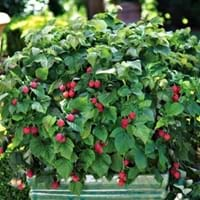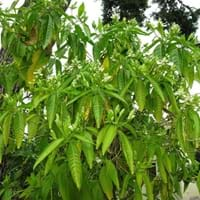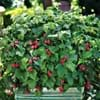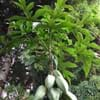Life Span
Perennial
Perennial
Type
Fruit
Herbs, Perennial
Origin
Hybrid origin
South-Eastern Asia
Types
not available
Not Available
Habitat
disturbed sites, Forest edges, old gardens, Riverbanks, Roadsides
Semi desert, Wet forest
USDA Hardiness Zone
4-9
9-11
Sunset Zone
A1, A2, A3, 1a, 1b, 2a, 2b, 3a, 3b, 4, 5, 6, 7, 8, 9, 10, 11, 12, 13, 14, 15, 16, 17, 18, 19, 20, 21, 22, 23, 24
Not Available
Habit
Upright/Erect
Clump-Forming
Minimum Width
Not Available
Flower Color Modifier
Bicolor
Bicolor
Fruit Color
Red
Not Available
Leaf Color in Spring
Green
Dark Green
Leaf Color in Summer
Green
Green, Light Green
Leaf Color in Fall
Green
Dark Green
Leaf Color in Winter
Light Green
Dark Green
Leaf Shape
Spade shaped
Elliptic
Plant Season
Spring, Summer, Fall
Spring, Summer, Fall, Winter
Sunlight
Full Sun, Partial Sun
Full Sun, Partial Sun, Partial shade
Growth Rate
Fast
Very Fast
Type of Soil
Loam, Sand
Clay, Loam, Sand
The pH of Soil
Acidic, Neutral
Acidic, Neutral, Alkaline
Soil Drainage
Well drained
Average
Bloom Time
Spring, Summer
Indeterminate
Tolerances
Drought
Wet Site
Where to Plant?
Container, Ground, Pot
Container, Ground
How to Plant?
Seedlings, Stem Planting, Transplanting
Stem Cutting
Plant Maintenance
Medium
Medium
Watering Requirements
Do Not over Water, Keep ground moist
Average Water Needs, Needs good drainage
In Summer
Lots of watering
Lots of watering
In Spring
Moderate
Moderate
In Winter
Average Water
Average Water
Soil pH
Acidic, Neutral
Acidic, Neutral, Alkaline
Soil Type
Loam, Sand
Clay, Loam, Sand
Soil Drainage Capacity
Well drained
Average
Sun Exposure
Full Sun, Partial Sun
Full Sun, Partial Sun, Partial shade
Pruning
Remove damaged leaves, Remove dead branches, Remove dead leaves
Cut away fading foliage, Cut upper 1/3 section when young to enhancegrowth, Remove damaged leaves, Remove dead branches, Remove dead leaves
Fertilizers
All-Purpose Liquid Fertilizer
All-Purpose Liquid Fertilizer, Don't use high pH fertilizers
Pests and Diseases
Red blotch
Aphids, Downy mildew, Dry root rot, Rust, Spider mites
Plant Tolerance
Drought
Heat Tolerance, Humidity
Flowers
Insignificant
Showy
Flower Petal Number
Single
Single
Foliage Texture
Medium
Medium
Foliage Sheen
Matte
Matte
Attracts
Butterflies
Aphids, Bees, Butterflies, Snails
Allergy
Skin rash
Dizziness, Mouth itching, Vomiting
Aesthetic Uses
Showy Purposes
Cottage Garden, Showy Purposes
Beauty Benefits
Good for skin
Good Cleanser, Good for the Scalp
Environmental Uses
Not Available
Air purification, Insect Repellent
Medicinal Uses
Sore throat, Ulcers, Wounds
Antipyretic, Bronchitis, Cough, Digestive disorders, Ear infections, Expectorant, Laxative, Migraines, Piles, Rheumatism, Throat infection, Treating fever
Part of Plant Used
Fruits
Bark, Leaf Stalks, Leaves
Other Uses
Edible syrup, Used As Food, Used as Ornamental plant
Biomass for fuel, Can be made into a herbal tea, Culinary use, Oil is used for aromatherapy, Used as a laxative
Used As Indoor Plant
No
No
Used As Outdoor Plant
Yes
Yes
Garden Design
Edible, Fruit / Fruit Tree, Hedges
Container, Hedges, Mixed Border, Screening / Wind Break, Tropical
Botanical Name
RUBUS 'Amity'
Justicia adhatoda
Common Name
Amity Raspberry, Raspberry
Malabar nut, Adulsa, Adhatoda, Vasaka
In Hindi
Raspberry
अडुळसा, अडुसा
In German
Himbeere
Indisches Lungenkraut
In French
Framboise
Justicia adhatoda
In Spanish
Frambuesa
Justicia adhatoda
In Greek
Βατόμουρο
Justicia adhatoda
In Portuguese
Framboesa
Justicia adhatoda
In Polish
Malina
Justicia adhatoda
In Latin
RUBUS IDAEUS
Justicia adhatoda
Phylum
Anthophyta
Magnoliophyta
Class
Eudicotyledones
Magnoliopsida
Order
Rosales
Scrophulariales
Family
Rosaceae
Acanthaceae
Clade
Not Available
Angiosperms, Monocots
Tribe
Not Available
Justicieae
Subfamily
Not Available
Acanthoideae
Importance of Raspberry and Malabar nut
Want to have the most appropriate plant for your garden? You might want to know the importance of Raspberry and Malabar nut. Basically, these two plants vary in many aspects. Compare Raspberry and Malabar nut as they differ in many characteristics such as their life, care, benefits, facts, etc. Every gardener must at least have the slightest clue about the plants he wants to plant in his garden. Compare their benefits, which differ in many ways like facts and uses. The medicinal use of Raspberry is Sore throat, Ulcers and Wounds whereas of Malabar nut is Antipyretic, Bronchitis, Cough, Digestive disorders, Ear infections, Expectorant, Laxative, Migraines, Piles, Rheumatism, Throat infection and Treating fever. Raspberry has beauty benefits as follows: Good for skin while Malabar nut has beauty benefits as follows: Good for skin.
Compare Facts of Raspberry vs Malabar nut
How to choose the best garden plant for your garden depending upon its facts? Here garden plant comparison will help you to solve this query. Compare the facts of Raspberry vs Malabar nut and know which one to choose. As garden plants have benefits and other uses, allergy is also a major drawback of plants for some people. Allergic reactions of Raspberry are Skin rash whereas of Malabar nut have Dizziness, Mouth itching and Vomiting respectively. Having a fruit bearing plant in your garden can be a plus point of your garden. Raspberry has showy fruits and Malabar nut has no showy fruits. Also Raspberry is not flowering and Malabar nut is not flowering . You can compare Raspberry and Malabar nut facts and facts of other plants too.





